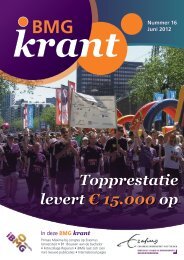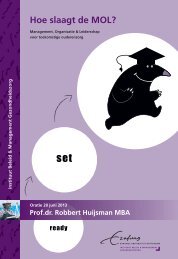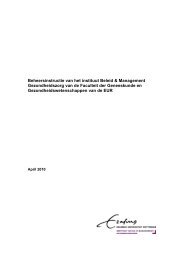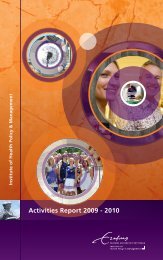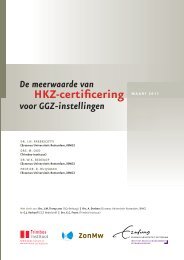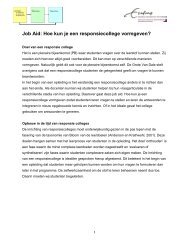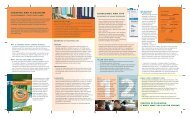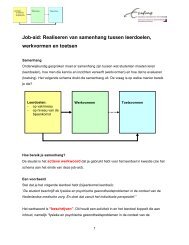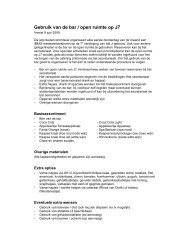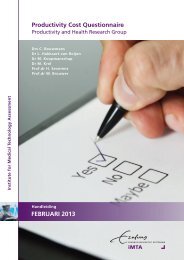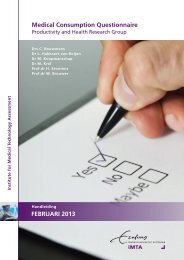38Chapter 33.2 MATERIALS AND METHODSThere is a close relationship between this study on the cost-effectiveness oftreatment for CDH and our study in ARM patients. For the purpose ofcomparability, the methodologies of both studies were replicated as far as it waspossible. We, therefore, have restricted ourselves to a brief description of ourmethodology, except for discrepancies between the 2 studies. For a more detaileddescription, please refer to Chapter 2.The data were collected in 1997, 1998, and 1999. Patients included underwenttreatment for CDH in the Sophia Children's Hospital in <strong>Rotterdam</strong> after 1969. Inprinciple, all patients until 1986 were treated by emergency surgery to close thediaphragmatic defect, followed by preoperative stabilization and delayed repairfrom that time onward. 12 ECMO was applied in the hospital from January 1992.Treatment of pulmonary hypertension with inhaled nitric oxide was not availableduring the study period. Patients born after 1996 were excluded to ensure aminimal follow-up period. Two patients were excluded because their CDH was notdiagnosed during the neonatal period. To examine to what extent respiratorydifficulties, stomach aches, and other disease-specific symptoms really areconsequences of CDH, we recruited a control group of children who visited theday care department in 1998 for minor day-case surgery.As with our study on ARM, the current study was carried out from a societalperspective using the technique of cost-utility analysis. Accordingly, the outcomesare presented in costs per quality-adjusted life year (QALY). 13 Both costs andeffects basically were analyzed in a life-time setting.Treatment comparatorIn economic evaluations of health care programs, treatments or diagnoses arecompared with one or more alternatives. Ideally, the alternative is the most costeffectivealternative treatment. More often, the studied program is compared withthe most common treatment (i.e., the existing, local practice). For CDH, however,there is no realistic alternative. Therefore, the costs and effects had to becompared with 'no treatment'. In this scenario, all diagnoses or treatments arewithheld; hence, no costs are generated. Furthermore, we assumed that in thisscenario, the inability to obtain sufficient oxygen uptake because of theunderlying lung anomalies would bring about death shortly after birth.CostsIdentification, measurement, and valuation of the costs. Direct medical costsmake up the health care cost incurred between the child's birth and the end ofthe hospital admission during which the defect in the diaphragm was closed.These costs were calculated only for patients born between 1993 and 1996,because computerized data on previous patients were lacking. Consistent with themethods outlined in Chapter 2 we calculated real costs of hospital days,
Cost-Effectiveness of Treatment for Congenital Diaphragmatic Hernia 39laboratory tests, diagnostic radiology, surgeries, intercollegial consultations, andvisits to the outpatient department. There is, however, one difference with ourprevious study. Costs of ECMO were calculated as part of the direct medical costs.These costs, i.e., the additional costs over the costs of a 'standard' day in anintensive care unit, were taken from a large Dutch survey on ECMO in neonates. 14Direct nonmedical costs are costs incurred outside the health care sector thataccrue to patients and their families while receiving health care. These costs werelimited to transportation costs regarding visits to health care providers.Indirect medical costs are the health care costs made after the period that refersto the direct medical costs. Costs of hospital admissions, visits to the outpatientdepartment, consultations with a general practitioner, and consultations with aphysiotherapist are all part of these costs. No reliable data were available oncosts of visits to alternative healers, use of medication outside the hospital, anduse of medicinal oxygen at home. We excluded future health care costs ofunrelated diseases.Indirect nonmedical costs are costs associated with production loss andreplacement owing to illness, disability, and death of productive persons, bothpaid and unpaid. 15 As we adopted a societal perspective, both productivitychanges in patients and in their parents or caregivers were included.EffectsIdentification, measurement, and valuation of the effects. We repeated themethodology outlined in the previous chapter regarding the effects. 4 In summary,we calculated both the life expectancy and the health-related quality of life. Weassumed that patients who survived the first few years would have a normal lifeexpectancy (75.4 years at birth 16 ). The life span of the deceased patients alsowas determined. On the basis of these data, the mean life expectancy wascalculated. Using the EQ-5D questionnaire, 17 we were then able to calculate theQALY gains. Descriptive quality-of-life data were collected using a disease-specificquestionnaire that aimed to measure respiratory difficulties, stomach aches, andother disease-specific symptoms. A symptom score of the most relevant clinicalitems was constructed, ranging from 0 to 45 (maximum number of symptoms).Medical consumption also was considered an indication of the quality of life.Generally, patients younger than 16 years did not fill in the questionnairesthemselves. Their parents were used as proxies. The disease-specificquestionnaire was the only exception. Here, the age limit was put at 12 years.Cost-effectivenessIncremental costs per QALY of treatment for CDH compared with 'no treatment'were calculated. Both future costs and future effects were discounted (to the
- Page 3: COST-EFFECTIVENESS OF NEONATAL SURG
- Page 6 and 7: DOCTORAL COMMITTEEPromotors:Prof.dr
- Page 9 and 10: PUBLICATIONSChapters 2 to 7 are bas
- Page 11: 6ChapterINFORMAL CARE FOR CHILDREN
- Page 14 and 15: 2Chapter 11.1 BACKGROUND AND MOTIVA
- Page 16 and 17: 4Chapter 1provides a good overview
- Page 18 and 19: 6Chapter 1disability, and death of
- Page 21: Introduction 9particular equity pri
- Page 25 and 26: Introduction 1320. Oostenbrink JB,
- Page 27 and 28: Introduction 1554. Heyman MB, Harma
- Page 29 and 30: THE COST-EFFECTIVENESS OFTREATMENT
- Page 31: Cost-Effectiveness of Treatment for
- Page 35 and 36: Cost-Effectiveness of Treatment for
- Page 37 and 38: Cost-Effectiveness of Treatment for
- Page 39 and 40: Cost-Effectiveness of Treatment for
- Page 41 and 42: Cost-Effectiveness of Treatment for
- Page 43 and 44: Cost-Effectiveness of Treatment for
- Page 45: Cost-Effectiveness of Treatment for
- Page 48 and 49: 36Chapter 3ABSTRACTBackground/Purpo
- Page 52 and 53: 40Chapter 3child's date of birth) a
- Page 54 and 55: 42Chapter 3diaphragm was closed (Ta
- Page 56 and 57: 44Chapter 3Total costs of treatment
- Page 58 and 59: 46Chapter 3Regarding the treatment
- Page 60 and 61: 48Chapter 3REFERENCES1. Stolk EA, P
- Page 62 and 63: 50Chapter 332. Jaillard S, Pierrat
- Page 64 and 65: 52Chapter 4ABSTRACTAims:To examine
- Page 66 and 67: 54Chapter 4Outcome measuresThe pati
- Page 68 and 69: 56Chapter 4Clearly, the symptoms st
- Page 70 and 71: 58Chapter 4The respondents did not
- Page 72 and 73: 60Chapter 4Table 4.4TAIQOL Scores o
- Page 74 and 75: 62Chapter 44.4 DISCUSSIONIn this pa
- Page 76 and 77: 64Chapter 4ACKNOWLEDGMENTSWe are in
- Page 78 and 79: 66Chapter 418. Coons SJ, Rao S, Kei
- Page 80 and 81: 68Chapter 5ABSTRACTObjective:Extrac
- Page 82 and 83: 70Chapter 5treatment. 26,27 Finally
- Page 84 and 85: 72Chapter 5CostsOnly direct costs w
- Page 86 and 87: 74Chapter 5summarized in Table 5.2.
- Page 88 and 89: 76Chapter 5Table 5.3 Direct Medical
- Page 90 and 91: 78Chapter 5Figure 5.3 illustrates o
- Page 92 and 93: 80Chapter 5severely ill newborns—
- Page 94 and 95: 82Chapter 5REFERENCES1. Bartlett RH
- Page 96 and 97: 84Chapter 533. Meinert CL: Extracor
- Page 98 and 99: 86Chapter 568. Hui TT, Danielson PD
- Page 100 and 101:
88Chapter 6ABSTRACTObjective:To inv
- Page 102 and 103:
90Chapter 6a rule. The health-relat
- Page 104 and 105:
92Chapter 6Regression analysis of h
- Page 106 and 107:
94Chapter 6that caregiving for thei
- Page 108 and 109:
96Chapter 6Table 6.5 CareQol Compar
- Page 110 and 111:
98Chapter 6children with a disabili
- Page 112 and 113:
100Chapter 6This study was of impor
- Page 114 and 115:
102Chapter 618. Poley MJ, Stolk EA,
- Page 116 and 117:
104Chapter 654. Boman KK, Viksten J
- Page 118 and 119:
106Chapter 7ABSTRACTMortality rates
- Page 120 and 121:
108Chapter 77.2 THE RELEVANCE OF CO
- Page 122 and 123:
110Chapter 7In the early 2000s, our
- Page 124 and 125:
112Chapter 7Table 7.1 Economic Eval
- Page 126 and 127:
114Chapter 7More from a policy pers
- Page 128 and 129:
116Chapter 7also expect that life-s
- Page 130 and 131:
118Chapter 7entirely justified, for
- Page 132 and 133:
120Chapter 723. Sydorak RM, Nijagal
- Page 134 and 135:
122Chapter 765. Glaser AW, Davies K
- Page 137 and 138:
GENERAL DISCUSSION:A GUIDED TOURPRO
- Page 139 and 140:
General Discussion: A Guided Tour P
- Page 141 and 142:
General Discussion: A Guided Tour P
- Page 143 and 144:
General Discussion: A Guided Tour P
- Page 145 and 146:
General Discussion: A Guided Tour P
- Page 147 and 148:
General Discussion: A Guided Tour P
- Page 149 and 150:
General Discussion: A Guided Tour P
- Page 151:
General Discussion: A Guided Tour P
- Page 154 and 155:
142GlossaryCharge (or: tariff)A pri
- Page 156 and 157:
144Glossaryefficient one. We are th
- Page 159 and 160:
SUMMARY
- Page 161 and 162:
Summary 149mortality. Finally, it i
- Page 163 and 164:
Summary 151neonatal surgery. It is
- Page 165 and 166:
SAMENVATTING
- Page 167 and 168:
Samenvatting 155zoals directe niet-
- Page 169 and 170:
Samenvatting 157Hoofdstuk 6 gaat ve
- Page 171:
Samenvatting 159vereisen, waarvoor
- Page 174 and 175:
162AcknowledgmentsAlthough I am ind
- Page 176:
About the AuthorBorn in De Meern (N





